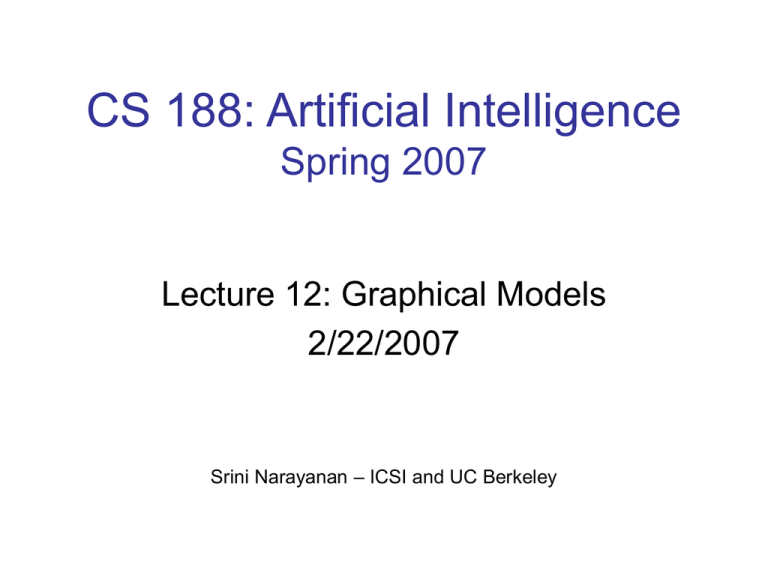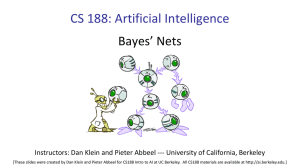Bayes Nets
advertisement

CS 188: Artificial Intelligence
Spring 2007
Lecture 12: Graphical Models
2/22/2007
Srini Narayanan – ICSI and UC Berkeley
Probabilistic Models
A probabilistic model is a joint distribution over a set of
variables
Given a joint distribution, we can reason about
unobserved variables given observations (evidence)
General form of a query:
Stuff you
care about
Stuff you
already know
This kind of posterior distribution is also called the belief
function of an agent which uses this model
Independence
Two variables are independent if:
This says that their joint distribution factors into a product two
simpler distributions
Independence is a modeling assumption
Empirical joint distributions: at best “close” to independent
What could we assume for {Weather, Traffic, Cavity, Toothache}?
How many parameters in the joint model?
How many parameters in the independent model?
Independence is like something from CSPs: what?
Example: Independence
N fair, independent coin flips:
H
0.5
H
0.5
H
0.5
T
0.5
T
0.5
T
0.5
Example: Independence?
Most joint distributions
are not independent
Most are poorly
modeled as
independent
T
P
S
P
warm
0.5
sun
0.6
cold
0.5
rain
0.4
T
S
P
T
S
P
warm
sun
0.4
warm
sun
0.3
warm
rain
0.1
warm
rain
0.2
cold
sun
0.2
cold
sun
0.3
cold
rain
0.3
cold
rain
0.2
Conditional Independence
P(Toothache,Cavity,Catch)?
If I have a cavity, the probability that the probe catches in it doesn't
depend on whether I have a toothache:
P(catch | toothache, cavity) = P(catch | cavity)
The same independence holds if I don’t have a cavity:
P(catch | toothache, cavity) = P(catch| cavity)
Catch is conditionally independent of Toothache given Cavity:
P(Catch | Toothache, Cavity) = P(Catch | Cavity)
Equivalent statements:
P(Toothache | Catch , Cavity) = P(Toothache | Cavity)
P(Toothache, Catch | Cavity) = P(Toothache | Cavity) P(Catch | Cavity)
Conditional Independence
Unconditional (absolute) independence is very rare
(why?)
Conditional independence is our most basic and robust
form of knowledge about uncertain environments:
What about this domain:
Traffic
Umbrella
Raining
What about fire, smoke, alarm?
The Chain Rule II
Can always factor any joint distribution as an incremental
product of conditional distributions
Why?
This actually claims nothing…
What are the sizes of the tables we supply?
The Chain Rule III
Trivial decomposition:
With conditional independence:
Conditional independence is our most basic and robust
form of knowledge about uncertain environments
Graphical models help us manage independence
The Chain Rule IV
Write out full joint distribution using chain rule:
P(Toothache, Catch, Cavity)
= P(Toothache | Catch, Cavity) P(Catch, Cavity)
= P(Toothache | Catch, Cavity) P(Catch | Cavity) P(Cavity)
= P(Toothache | Cavity) P(Catch | Cavity) P(Cavity)
Cav
P(Cavity)
Graphical model notation:
• Each variable is a node
T
Cat
• The parents of a node are the
other variables which the
decomposed joint conditions on
• MUCH more on this to come!
P(Toothache | Cavity)
P(Catch | Cavity)
Combining Evidence
P(cavity | toothache, catch)
= P(toothache, catch | cavity) P(cavity)
= P(toothache | cavity) P(catch | cavity) P(cavity)
C
This is an example of a naive Bayes model:
E1
E2
En
Graphical Models
Models are descriptions of how
(a portion of) the world works
Models are always simplifications
May not account for every variable
May not account for all interactions
between variables
What do we do with probabilistic models?
We (or our agents) need to reason about unknown variables,
given evidence
Example: explanation (diagnostic reasoning)
Example: prediction (causal reasoning)
Example: value of information
Bayes’ Nets: Big Picture
Two problems with using full joint distributions for
probabilistic models:
Unless there are only a few variables, the joint is WAY too big to
represent explicitly
Hard to estimate anything empirically about more than a few
variables at a time
Bayes’ nets (more properly called graphical models) are
a technique for describing complex joint distributions
(models) using a bunch of simple, local distributions
We describe how variables locally interact
Local interactions chain together to give global, indirect
interactions
Graphical Model Notation
Nodes: variables (with domains)
Can be assigned (observed) or
unassigned (unobserved)
Arcs: interactions
Similar to CSP constraints
Indicate “direct influence” between
variables
For now: imagine that arrows
mean causation
Example: Coin Flips
N independent coin flips
X1
X2
Xn
No interactions between variables:
absolute independence
Example: Traffic
Variables:
R: It rains
T: There is traffic
R
Model 1: independence
T
Model 2: rain causes traffic
Why is an agent using model 2 better?
Example: Traffic II
Let’s build a causal graphical model
Variables
T: Traffic
R: It rains
L: Low pressure
D: Roof drips
B: Ballgame
C: Cavity
Example: Alarm Network
Variables
B: Burglary
A: Alarm goes off
M: Mary calls
J: John calls
E: Earthquake!
Bayes’ Net Semantics
Let’s formalize the semantics of a
Bayes’ net
A1
An
A set of nodes, one per variable X
A directed, acyclic graph
A conditional distribution for each node
X
A distribution over X, for each combination
of parents’ values
CPT: conditional probability table
Description of a noisy “causal” process
A Bayes net = Topology (graph) + Local Conditional Probabilities
Probabilities in BNs
Bayes’ nets implicitly encode joint distributions
As a product of local conditional distributions
To see what probability a BN gives to a full assignment, multiply
all the relevant conditionals together:
Example:
This lets us reconstruct any entry of the full joint
Not every BN can represent every full joint
The topology enforces certain conditional independencies
Example: Coin Flips
X1
X2
Xn
h
0.5
h
0.5
h
0.5
t
0.5
t
0.5
t
0.5
Only distributions whose variables are absolutely independent
can be represented by a Bayes’ net with no arcs.
Example: Traffic
R
r
T
r
r
1/4
r
3/4
t
3/4
t
1/4
t
1/2
t
1/2
Example: Alarm Network
Example: Naïve Bayes
Imagine we have one cause y and several effects x:
This is a naïve Bayes model
We’ll use these for classification later
Example: Traffic II
Variables
L
T: Traffic
R: It rains
L: Low pressure
D: Roof drips
B: Ballgame
R
D
B
T
Size of a Bayes’ Net
How big is a joint distribution over N Boolean variables?
How big is an N-node net if nodes have k parents?
Both give you the power to calculate
BNs: Huge space savings!
Also easier to elicit local CPTs
Also turns out to be faster to answer queries (next class)
Building the (Entire) Joint
We can take a Bayes’ net and build the full joint
distribution it encodes
Typically, there’s no reason to build ALL of it
But it’s important to know you could!
To emphasize: every BN over a domain implicitly
represents some joint distribution over that
domain
Example: Traffic
Basic traffic net
Let’s multiply out the joint
R
r
T
r
r
1/4
r
3/4
t
3/4
t
1/4
t
1/2
t
1/2
r
t
3/16
r
t
1/16
r
t
6/16
r
t
6/16
Example: Reverse Traffic
Reverse causality?
T
t
R
t
t
9/16
t
7/16
r
1/3
r
2/3
r
1/7
r
6/7
r
t
3/16
r
t
1/16
r
t
6/16
r
t
6/16
Causality?
When Bayes’ nets reflect the true causal patterns:
Often simpler (nodes have fewer parents)
Often easier to think about
Often easier to elicit from experts
BNs need not actually be causal
Sometimes no causal net exists over the domain (especially if
variables are missing)
E.g. consider the variables Traffic and Drips
End up with arrows that reflect correlation, not causation
What do the arrows really mean?
Topology may happen to encode causal structure
Topology really encodes conditional independencies
Creating Bayes’ Nets
So far, we talked about how any fixed Bayes’ net
encodes a joint distribution
Next: how to represent a fixed distribution as a
Bayes’ net
Key ingredient: conditional independence
The exercise we did in “causal” assembly of BNs was
a kind of intuitive use of conditional independence
Now we have to formalize the process
After that: how to answer queries (inference)
Estimation
How to estimate the a distribution of a random variable X?
Maximum likelihood:
Collect observations from the world
For each value x, look at the empirical rate of that value:
This estimate is the one which maximizes the likelihood of the data
Elicitation: ask a human!
Harder than it sounds
E.g. what’s P(raining | cold)?
Usually need domain experts, and sophisticated ways of eliciting
probabilities (e.g. betting games)
Estimation
Problems with maximum likelihood estimates:
If I flip a coin once, and it’s heads, what’s the estimate for
P(heads)?
What if I flip it 50 times with 27 heads?
What if I flip 10M times with 8M heads?
Basic idea:
We have some prior expectation about parameters (here, the
probability of heads)
Given little evidence, we should skew towards our prior
Given a lot of evidence, we should listen to the data
How can we accomplish this? Stay tuned!




